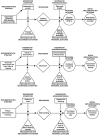From Classification to Causality: Advancing Understanding of Mechanisms of Change in Implementation Science
- PMID: 29868544
- PMCID: PMC5949843
- DOI: 10.3389/fpubh.2018.00136
From Classification to Causality: Advancing Understanding of Mechanisms of Change in Implementation Science
Abstract
Background: The science of implementation has offered little toward understanding how different implementation strategies work. To improve outcomes of implementation efforts, the field needs precise, testable theories that describe the causal pathways through which implementation strategies function. In this perspective piece, we describe a four-step approach to developing causal pathway models for implementation strategies.
Building causal models: First, it is important to ensure that implementation strategies are appropriately specified. Some strategies in published compilations are well defined but may not be specified in terms of its core component that can have a reliable and measureable impact. Second, linkages between strategies and mechanisms need to be generated. Existing compilations do not offer mechanisms by which strategies act, or the processes or events through which an implementation strategy operates to affect desired implementation outcomes. Third, it is critical to identify proximal and distal outcomes the strategy is theorized to impact, with the former being direct, measurable products of the strategy and the latter being one of eight implementation outcomes (1). Finally, articulating effect modifiers, like preconditions and moderators, allow for an understanding of where, when, and why strategies have an effect on outcomes of interest.
Future directions: We argue for greater precision in use of terms for factors implicated in implementation processes; development of guidelines for selecting research design and study plans that account for practical constructs and allow for the study of mechanisms; psychometrically strong and pragmatic measures of mechanisms; and more robust curation of evidence for knowledge transfer and use.
Keywords: causal pathway; implementation; mechanism; mediator; moderator; strategy; theory.
References
Grants and funding
LinkOut - more resources
Full Text Sources
Other Literature Sources


